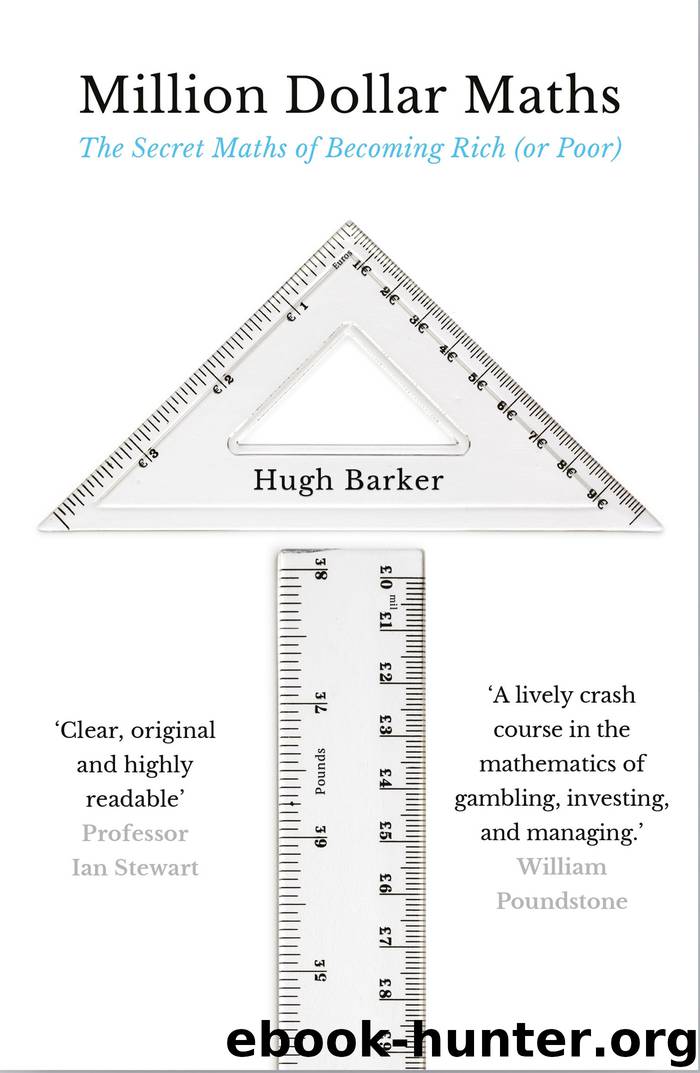Million Dollar Maths by Hugh Barker

Author:Hugh Barker
Language: eng
Format: epub
Publisher: Atlantic Books
An Introduction to Cardcounting
One of the most common card games in casinos around the world is blackjack. And the really curious thing about blackjack is that it is a game that is eminently beatable by a sufficiently skilled cardcounter, and the casinos have known this, at the very least, since the publication of Beat the Dealer.
The first two points to make about cardcounting are that it is neither as difficult nor as easy as it might sound. The actual systems used to count cards do not involve any great mathematical skill or astounding feats of memory. Do not imagine that you need to be like the autistic savant in Rain Man who is able to memorize the exact order of six packs of cards: the process is far simpler than that. However, you do need great reserves of patience, calm, and an ability to stick to the system without getting rushes of blood, and you also need to know about the many ways in which casinos attempt to discourage or defeat cardcounters.
Cardcounters may well have been raking in profits from the early days of blackjack (it was only a legal game in the US from the 1930s, but had been around in one form or another in Europe and America since at least the sixteenth century). The so-called ‘Four Horsemen of Blackjack’ (Baldwin, Cantey, Maisel, McDermott) wrote a book in 1957 called Playing Blackjack to Win which discussed keeping track of cards as a way to tilt the game in your favour. But it was Thorp’s Beat the Dealer that reached a much wider audience, making many more gamblers (and casinos) aware of the mathematics of cardcounting.
The basic principle behind cardcounting relies on the fact that when the remaining deck (or combined set of decks) of cards contains a high proportion of low cards (from two to seven) it benefits the dealer, while a deck containing a high proportion of cards worth 10 (ten to king) or aces (depending on the system) benefits the player. Thorp, who was looking at the traditional single-deck deal, analysed this mathematically and recommended a ‘ten-count’ system in which you start from a count of the sixteen cards worth 10, and of the thirty-six other cards, then divide the latter by the former to keep track of how the dealer’s edge was varying.
Most subsequent cardcounters have concluded that it is better to use a simpler system, especially given the complications introduced by dealers working with six packs of cards instead of a single deck (a measure introduced specifically to make cardcounting more difficult). For instance, the basic ‘Hi–Lo system’ allots a value of 1 to cards two to six, a value of 0 to cards seven to nine, and a value of –1 to cards from ten to ace. All the cardcounter needs to do is to add up the value of the cards dealt and to keep a running count of the positive or negative total. (There are also other cardcounting systems you could choose, with names such as Omega, Hi-Opt and KO.
Download
This site does not store any files on its server. We only index and link to content provided by other sites. Please contact the content providers to delete copyright contents if any and email us, we'll remove relevant links or contents immediately.
| Algebra | Calculus |
| Combinatorics | Discrete Mathematics |
| Finite Mathematics | Fractals |
| Functional Analysis | Group Theory |
| Logic | Number Theory |
| Set Theory |
Modelling of Convective Heat and Mass Transfer in Rotating Flows by Igor V. Shevchuk(6408)
Weapons of Math Destruction by Cathy O'Neil(6221)
Factfulness: Ten Reasons We're Wrong About the World – and Why Things Are Better Than You Think by Hans Rosling(4718)
A Mind For Numbers: How to Excel at Math and Science (Even If You Flunked Algebra) by Barbara Oakley(3262)
Descartes' Error by Antonio Damasio(3250)
Factfulness_Ten Reasons We're Wrong About the World_and Why Things Are Better Than You Think by Hans Rosling(3218)
TCP IP by Todd Lammle(3158)
Fooled by Randomness: The Hidden Role of Chance in Life and in the Markets by Nassim Nicholas Taleb(3083)
Applied Predictive Modeling by Max Kuhn & Kjell Johnson(3043)
The Tyranny of Metrics by Jerry Z. Muller(3034)
The Book of Numbers by Peter Bentley(2935)
The Great Unknown by Marcus du Sautoy(2666)
Once Upon an Algorithm by Martin Erwig(2627)
Easy Algebra Step-by-Step by Sandra Luna McCune(2607)
Lady Luck by Kristen Ashley(2557)
Police Exams Prep 2018-2019 by Kaplan Test Prep(2518)
Practical Guide To Principal Component Methods in R (Multivariate Analysis Book 2) by Alboukadel Kassambara(2516)
All Things Reconsidered by Bill Thompson III(2374)
Linear Time-Invariant Systems, Behaviors and Modules by Ulrich Oberst & Martin Scheicher & Ingrid Scheicher(2348)
